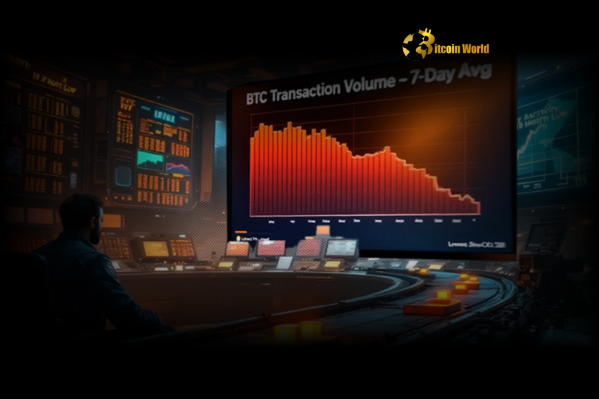BitcoinWorld

Bitcoin Transactions Plummet: Analyzing the 18-Month Low in Network Activity
The pulse of the Bitcoin network, measured by the volume of transactions processed, has recently slowed to an 18-month low. This dip in Bitcoin transactions signals a shift in user behavior and network dynamics, particularly following periods of intense activity driven by new protocols.
What’s Behind the Decline in Bitcoin Transactions?
According to data analyzed by The Block, the weekly average for Bitcoin transactions has fallen significantly, currently hovering around 350,000 per day. This represents a sharp contrast to the highs seen earlier in 2024, when daily transaction counts often exceeded 700,000.
The primary driver cited for this decrease is the cooling interest in novel Bitcoin-native protocols. Specifically, the excitement and activity surrounding Bitcoin Ordinals and Bitcoin Runes appear to have subsided from their peaks.
- Bitcoin Ordinals: Introduced in early 2023, Ordinals allow for the inscription of data onto individual satoshis (the smallest unit of Bitcoin), effectively creating unique digital artifacts similar to NFTs directly on the Bitcoin blockchain. This sparked a surge in transaction volume as users rushed to create and trade these inscriptions.
- Bitcoin Runes: Launched more recently, Runes provide a standard for creating fungible tokens on the Bitcoin network, offering an alternative to previous methods like BRC-20. Its launch in April 2024 coincided with the latest Bitcoin halving and generated significant buzz, leading to another spike in network activity and transaction fees.
The initial hype cycles for both Ordinals and Runes generated substantial transaction volume, often dominating block space and driving up transaction fees. As the novelty wears off and speculative interest decreases, the volume associated with these specific activities naturally declines, pulling down the overall Bitcoin network activity figures.
Understanding Bitcoin Network Activity Trends
Monitoring Bitcoin network activity provides valuable insights into the network’s usage patterns, user demand for block space, and indirectly, market sentiment. Transaction volume isn’t the only metric, but it’s a significant one. Historical data shows that transaction counts often correlate with market cycles, typically increasing during bull markets driven by speculation and trading, and decreasing during quieter periods.
However, the recent surge and subsequent decline linked to Ordinals and Runes highlight how new use cases built on Bitcoin can dramatically influence these metrics, independent of broader market sentiment to some extent. While the overall market hasn’t crashed, the specific niche activity that inflated transaction counts has reduced.
Let’s look at a simplified comparison of network state during high vs. low volume periods:
| Metric | Peak Activity (e.g., during Runes launch) | Current Low Activity |
|---|---|---|
| Daily Transactions (Approx. Weekly Avg) | ~700,000+ | ~350,000 |
| Demand for Block Space | High | Moderate to Low |
| Median Transaction Fee | Significantly Higher (e.g., $30-$100+) | Significantly Lower (e.g., $1-$5) |
| Transaction Confirmation Time | Potentially Longer (due to congestion) | Generally Faster |
| Primary Transaction Drivers | Standard transfers, trading, Ordinals, Runes | Standard transfers, trading |
This table illustrates the direct impact of fluctuating transaction volume on key user experience factors like fees and confirmation times.
The Impact on Bitcoin Fees
One of the most immediate and tangible effects of decreased Bitcoin network activity is the drop in Bitcoin fees. When the network is congested with a high volume of transactions competing for limited block space, users must offer higher fees to incentivize miners to include their transactions quickly. Conversely, when transaction volume falls, the competition for block space decreases, and lower fees are sufficient for timely confirmations.
For everyday users sending standard Bitcoin transactions, this period of lower volume translates directly into cheaper transfers. While high fees during peak times can make small transactions uneconomical, the current environment is much more favorable for general usage.
For Bitcoin miners, however, the decline in transaction volume and the resulting lower fees represent a decrease in revenue. Miner revenue comes from two sources: the block subsidy (newly minted Bitcoin) and transaction fees. With the block subsidy halving periodically (most recently in April 2024), transaction fees become an increasingly important part of a miner’s income. A sustained period of low transaction volume and fees can put pressure on mining profitability.
What Does This Mean for the Future of Bitcoin Ordinals and Runes?
The cooling interest in Bitcoin Ordinals and Bitcoin Runes doesn’t necessarily mean these protocols are gone forever. It’s more likely that the initial speculative frenzy has passed, and activity is settling into a more sustainable pattern. Developers continue to build on these standards, and they may see renewed interest in the future, perhaps driven by new applications or market shifts.
The episode highlights both the potential and the challenges of building new layers and use cases directly on the Bitcoin base layer. While they can bring innovation and drive network usage, they can also create significant network congestion and fee volatility if not managed carefully or if interest is purely speculative.
Actionable Insights from the Transaction Dip
For different participants in the Bitcoin ecosystem, the current low in Bitcoin transactions offers specific takeaways:
- For Users: Now is a relatively inexpensive time to make on-chain Bitcoin transactions. If you needed to consolidate UTXOs or move funds, current Bitcoin fees are significantly lower than they were months ago.
- For Miners: This period underscores the importance of operational efficiency and adapting to variable revenue streams. Reliance on transaction fees can be volatile.
- For Developers: The Runes/Ordinals cycle provides valuable data on network stress points and user behavior when new protocols are introduced. It emphasizes the need for scalable solutions and potentially layered approaches.
- For Investors: A dip in transaction volume isn’t necessarily a bearish signal for Bitcoin’s price, though it can reflect decreased speculative activity. It’s important to look at transaction volume alongside other metrics and the broader market context.
Conclusion: A Natural Fluctuation or a Deeper Trend?
The recent drop in Bitcoin transactions to an 18-month low is a notable data point, primarily attributed to the reduced hype surrounding Bitcoin Ordinals and Bitcoin Runes. This highlights how specific, popular applications can temporarily skew network activity metrics. While it results in lower Bitcoin fees and potentially less congestion for standard transactions, it also impacts miner revenue.
Whether this low volume persists or is merely a temporary lull before the next wave of network activity remains to be seen. The Bitcoin network is dynamic, constantly evolving with new users, developers, and use cases. Monitoring these trends is crucial for understanding the health and development of the ecosystem.
To learn more about the latest Bitcoin trends, explore our articles on key developments shaping Bitcoin network activity and fees.
This post Bitcoin Transactions Plummet: Analyzing the 18-Month Low in Network Activity first appeared on BitcoinWorld and is written by Editorial Team





